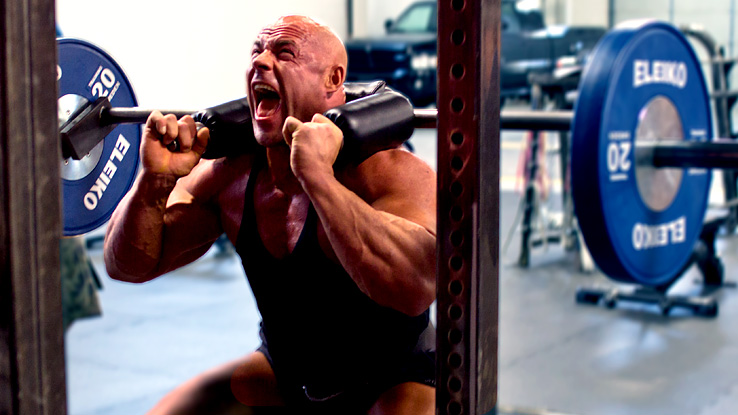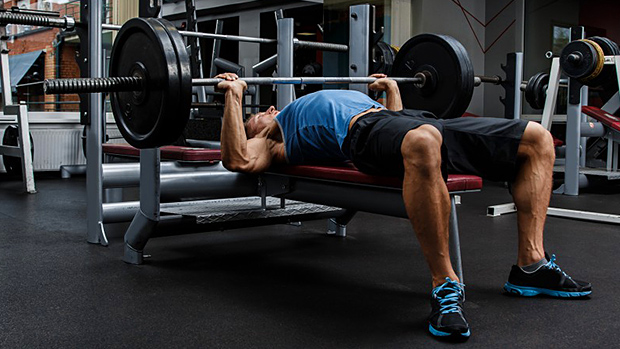Here's what you need to know...
- Power is the product of equal parts strength and speed.
- You can't be powerful if you're not fast.
- Those who are naturally strong need to work on getting faster. Conversely, those who are naturally fast/reactive need to get stronger.
- To build power you need a multi-faceted approach, dedicating time to maximal strength training, plyometric training, ballistic training, and contrast training.
- The end result of training for power is better performance in the gym (in terms of total amount of weight lifted) and improved performance in your respective sport (in terms of your ability to accelerate, decelerate, jump higher, sprint faster, and change direction on a dime).
Those athletes who get the full scholarships, as well as those guys in the gym who not only lift a metric shit-ton of weight, but do so in the blink of an eye, all share one common characteristic: Power.
Power is the product of equal parts strength and speed. In simplest terms, those athletes and weekend warriors who are powerful can typically generate force quickly, which equates to a high rate of force development (RFD). Furthermore, the ability to generate high levels of force is dependent on how efficient you are at recruiting high-threshold motor units. In doing so, the end result is better performance in the gym in terms of total amount of weight lifted. For sports, the end result is improved performance in terms of your ability to accelerate, decelerate, jump higher, sprint faster, and change direction on a dime.
Power: I Want Some!
All of this leads to the obvious question: How do you go about increasing power? Unfortunately, many trainees tackle power training with a one-trick pony approach, taking the mindset that "just getting strong" is all they need to concentrate their efforts on. While not wrong and certainly a nice place to start, it's only one piece of the puzzle. An important piece, but only one piece nonetheless.
Power is not maximal strength. The key distinction is that you can't be powerful if you're not fast. If maximal strength were all that was needed, then we'd have a long list of powerlifters who held world records in the vertical and long jump. As Mike Robertson notes, "We know maximal strength gives us a foundation, or the potential, to be more explosive. However, training for max strength alone isn't enough. At some point you must focus on converting that strength to power. In sports it's rare that you have enough time to generate maximal force. It's not like powerlifting where you have an infinite amount of time to finish a lift. Instead, the goal is to create force quickly."
For the more visual readers in the crowd, it's helpful to look at the Force-Velocity Curve.

In order to develop power you need to explore and develop a spectrum of "qualities." The Force-Velocity Curve (also referred to as the Strength-Speed Continuum) showcases the relationship between... well, force and velocity. More to the point, it shows an inverse relationship between weight (force) and the velocity (speed) employed to lift it. At the far left we have maximal, or absolute strength. At the far right we have speed, or ballistic training.
The heavier the load lifted, the slower the movement. Conversely, the lighter the load, the faster the movement. And then we have everything in between like speed-strength, strength-speed, and holy-shit-that-was-fast, all of which deserve their time in the limelight and play a role in enhancing power.
Taking the conversation back to the "just get strong" argument, we can see how that mindset isn't entirely effective and is borderline faulty logic. If developing power is the goal, which, again, encompasses an entire spectrum and several categories to express, it's important to train along the entire curve in order to get stronger and faster.
Figuring Out Where You Are on the Curve
Even if you're not an athlete but want to improve power anyhow, figuring out where you're currently residing on the Strength-Speed Continuum will dictate where and how you should spend the majority of your efforts in the weight room.
Full disclosure: The best approach is one that dedicates some time to each category.
However, depending on your current status, you may need to prioritize certain components over others. Those who've been hanging out on the right side of the spectrum - namely, beginner and intermediate lifters who have dabbled in sports and are accustomed to performing plyometric-type activities - would do well with more time dedicated to strength training.
Those more biased to the left - advanced trainees (those with a solid 2-3 years of training) who tend to avoid sports and explosive training - would do well with more dedicated speed or reactive training.
Different people are going to lie at different places on the curve due to genetics, training preferences, goals, and/or demands of the sport, but the idea would be to implement different exercises/protocols throughout the week or cycles throughout the training year so that you can "express" those qualities at any given time.
Why Strength Is Still a Big Deal
Most young athletes, and honestly, most regular Joes, spend the majority of their time hanging out at the reactive/speed end of the spectrum and they'd do well by flipping the script and getting stronger. It's like this: I can take a Ford Focus and give it a sweet paint job, 17" rims, and a spoiler and make it look fast, but unless I increase the horsepower of the engine, we're not going to win any NASCAR races anytime soon.
Make no mistake, strength is the foundation for pretty much everything. Using another great analogy, we can think of strength as a glass, and the liquid filling the glass as all the qualities that are enhanced or improved by actually having it (endurance, strength endurance, agility, power, etc.). Many people have a glass that's simply too small, which is why they never see any marked improvements in the weight room or on the field. They've filled their glass with all the liquid it can hold.
Conversely, taking a detour in the other direction, and placing a premium on getting stronger, will make the glass bigger, and hence allow more "qualities" (liquid) to be poured into the glass. Unfortunately many coaches, trainers, parents, and maybe even you, fail to see this.
Many will say that heavy lifting performed slowly will make you slow, and if the goal is to get fast or to increase power, you need to lift fast. In addition, researchers will make mention of RFD for faster running speeds. All of this is true and carries weight (no pun intended). If we can't produce force fast we can't lift weights fast. But as strength coach, Travis Hansen, beautifully states, "What about if we produce force fast, but produce a small amount of force?"
This is why only focusing on speed work is misguided, especially if you're an intermediate or beginner lifter. It's important to get strong, and it's important to incorporate heavy lifting to help improve or maintain power. It's great to own a 3x bodyweight deadlift or to be able to squat Godzilla, but it's a moot attribute to have if you have the movement quality of the Tin Man and it takes you 17 seconds to run a pick-n-roll in your recreational basketball league. All that said, there's a degree of self-auditing here. Those who are naturally strong need to work on getting faster. Conversely, those who are naturally fast/reactive need to get stronger.
All that said, most people are going to lie somewhere in the middle and would be best served utilizing a multi-faceted approach to improve power, and breaking it down into categories.
1 – Maximal Strength Training
This would be your run-of-the-mill lifting heavy stuff scenario. There's no time requirement here. If you take three seconds or 30 seconds to finish a lift, it won't matter, although, with regards to the latter, that kind of lift may require a new pair of underwear.
Depending on your experience, training "maximal" strength could also include a spectrum and could range anywhere from utilizing a 5x5 approach to incorporating more lifts at or above 90% of your one-rep max. For most people, however, training at that high of an intensity can be borderline dangerous and it's something I don't recommend for beginner and intermediate lifters. Instead, I prefer using a "ramp up" system where the objective is to work up to 3-rep max (for that day) and then hitting a certain number of sets in the 90% range of that number.
There's a degree of auto-regulation and "feel" involved, and results will vary depending on one's status for that day, but it gets the job done and I feel it's a far better fit for most trainees. Lets use a quick example using the bench press. The goal is to hit 4 sets at or above 90% of 3RM. The "ramp" will look like this:
- Bar only x whatever
- 95 x 5
- 135 x 5
- 185 x 3
- 225 x 3 (bar speed is still good)
- 245 x 3 (starting to slow up, but still passable)
- 265 x 3 (last rep was a bit of a grinder. We'll use this as our marker or top set for the day)
Doing the math, 90% of 265 is 238.5. Any lift above 238.5 counts (245 and 265, respectively). As always, I'd opt for clean, fast reps and would encourage someone to stick in the 245-255 range for their last two sets. This is a strategy that could be applied to all the big lifts (squat, deadlift, bench press, chin-up, rows). Sorry, triceps kickbacks are off the list.
Be conservative with how often it's applied. One to two sessions per week would suffice - maybe use it for one lower body movement and one upper body movement - but once a week would be a nice option for most.
- Week 1: ramp up to a 3RM deadlift, hit 3-5 sets at 90%+
- Week 2: ramp up to a 3RM bench press, hit 3-5 sets at 90%+
- Week 3: ramp up to a 3RM squat, hit 3-5 sets at 90%+
- Week 4: ramp up to a 3RM deadlift (try to beat your previous number), hit 3-5 sets at 90%+
I find this is a much more user friendly way to implement the rule of 90% and something that most trainees could easily implement into their training.
2 – Plyometric Training
Many are quick to correlate speed or power training with plyometric training and they're certainly not wrong. Plyos are a fantastic to way to help develop RFD by incorporating a strong eccentric (i.e., taking advantage of the stretch shortening cycle) to garner more force in the tendons to propel the body in a specific direction (since power is plane or vector specific!)
Something to consider, though, is that plyometric training - traditionally recognized as various jumping, bounding, and hopping exercises - is very taxing on the nervous system and many people are too liberal with its application. In other words, it's far better to think quality of ground contacts here rather than quantity. In addition, it's best to lean on the conservative side. In other words, let's limit the 40" altitude landings, okay?
The bulk of our plyo training revolves around skipping drills, Heidens, and box jumps. Sprinting is also involved, and can be considered plyometric, but that will be discussed in detail below.
Skipping Drills
You'd be surprised as to how many people can't skip due to lack of coordination, and if they can, it resembles something more like "Dorothy skipping down the yellow-brick road" than anything remotely athletic.
The objective here is to coordinate the hip and arm action. Key cues to consider:
- Break a pane of glass with your knees.
- Prevent the hips from swiveling.
- Keep kneecaps facing forward.
- Toss a stone behind you (hand action).
Here we're getting more rhythmic with the skipping. In addition, ground contact time should be very brief.
As the name implies, the objective here is to jump as high (and far) as possible with each skip.
The objective here is to stay rhythmic with the skipping, but to also jump as high (and far) as you can every third jump.
Heidens
We use these a ton with our baseball players (more plane specific), but they're also a great fit for non-baseball players since they force people to get out of the sagittal plane and include more lateral work. Key cues to consider:
- Get "into" or load your hip to get out of it (explode).
- Knee should stay inside the foot.
- Think distance, and land soft!
Box Jumps
Box jumps can be a double-edged sword. Most guys need to check their ego at the door and understand that the objective isn't so much how high you can jump (and risk destroying your shins), but rather learning to decelerate your bodyweight, absorb force, and to land correctly (soft and with chest up and hips back). You should end how you start. If you jump and end up bending over (chest touches thighs) or you land with a loud thump, it's too high.
Start with a pre-stretch (reach for the sky), throw arms down, and jump up making sure to land correctly.
Try to make it a point to make an approach with each leg, and not just the same one every time.
Jumping with the dumbbells overloads the eccentric portion, which yields a higher jump.
This is my favorite variation as it helps improve starting strength and explosiveness. A key point to consider is to use a box height that places you around 90 degrees of hip flexion.
Training Parameters
Ideally these drills will be done prior to a lower body session. They can also be divided into linear and lateral days.
Linear Day (Sample)
| Exercise | Sets | Reps | |
|---|---|---|---|
| A | High Knee March | 3 | 10 yds |
| B | High Knee Skips | 3 | 15-20 yds |
| C | Box Jump | 4 | 3 |
Lateral Day (Sample)
| Exercise | Sets | Reps | |
|---|---|---|---|
| A | High Knee March | 3 | 10 yds |
| B | Lateral High Knee Skip | 3 | 15-20 yds |
| C | Heidens | 3 | 5/leg |
3 – Ballistic Training
Not to be confused with plyometric training, ballistic based movements erase the deceleration component of the lift and focus entirely on acceleration, specifically releasing weight. I know what some of you are thinking, "Dude, Tony, I'm a bro and perform speed bench and speed squats every week. I already do ballistic training." Not so fast. You still need to decelerate the bar as a protective mechanism as you approach the concentric end range of motion. Furthermore, with typical Dynamic Effort (DE) movements, the more speed you generate at the start will only force the body to shut down towards the end range.
That's why medicine ball training fits so nicely. Here you can focus solely on acceleration and not worry about your CNS putting on the brakes. To that end, for power purposes, I like to separate med ball training into a light day where the objective is speed, and a heavy day where the objective is distance. In addition I like to pair med ball drills with upper body training days.
Light Day Medicine Ball Drills
- Weight: 4-8 pounds
- Key Cues: Try to break the wall or floor
Also, with the rotational drills, it's important to coordinate the torso and hip rotation simultaneously. In other words, the back foot and hip should rotate. Perform ONE rotational movement, and ONE overhead movement, 2-4 sets of 8-10 reps (overhead drills), 6-8 reps/side (rotational drills).
Heavy Medicine Ball Drills
- Weight: 10-20 pounds
- Objective: distance!
Just choose ONE drill on these days.
4 – Contrast Training
The objective of contrast training is to perform a strength-based movement to activate and/or potentiate high-threshold motor units and then follow that with an explosive movement (jump, sprint, etc.) that closely emulates the same movement pattern.
Some general rules to follow:
- The strength work shouldn't last longer than 10-20 seconds. For most this will equate to 2-4 reps. Go heavy!
- Rest 10-20 seconds between the strength movement and the sprint or jump.
- Full recovery after that.
- If you're going to include contrast training into the mix, that IS the workout. You'll perform anywhere from 6-8 sets, followed by maybe 1-2 accessory movements.
Final Thoughts
- Developing power can't be pinpointed to one thing or component. You need to train amongst a spectrum, but you also need to audit yourself to figure out where the bulk of your efforts should lie.
- When it comes to plyometric training, it's important to think quality over quantity.
- Don't scoff at the skipping drills. You'd be surprised how many people have a hard time with them.
- Some of you are ready to grab the pitchforks at the fact that I didn't dedicate any time to the Olympic lifts. I have nothing against them and wholeheartedly feel they have a place. But given the heavy learning curve with regards to technique and since the bulk of people don't have access to a good coach, I wanted to highlight things that could easily be implemented right away.





